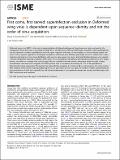Files in this item
First come, first served : superinfection exclusion in Deformed wing virus is dependent upon sequence identity and not the order of virus acquisition
Item metadata
| dc.contributor.author | Gusachenko, Olesya | |
| dc.contributor.author | Woodford, Luke | |
| dc.contributor.author | Balbirnie-Cumming, Katharin | |
| dc.contributor.author | Evans, David J. | |
| dc.date.accessioned | 2021-07-14T11:30:11Z | |
| dc.date.available | 2021-07-14T11:30:11Z | |
| dc.date.issued | 2021-06-30 | |
| dc.identifier | 274789330 | |
| dc.identifier | d2b3869b-e314-4288-88f6-49a4b1a45a61 | |
| dc.identifier | 000668440900001 | |
| dc.identifier | 85120021860 | |
| dc.identifier.citation | Gusachenko , O , Woodford , L , Balbirnie-Cumming , K & Evans , D J 2021 , ' First come, first served : superinfection exclusion in Deformed wing virus is dependent upon sequence identity and not the order of virus acquisition ' , ISME Journal . https://doi.org/10.1038/s41396-021-01043-4 | en |
| dc.identifier.issn | 1751-7362 | |
| dc.identifier.other | ORCID: /0000-0003-2530-2120/work/96817626 | |
| dc.identifier.other | ORCID: /0000-0002-1315-4258/work/104252499 | |
| dc.identifier.uri | https://hdl.handle.net/10023/23549 | |
| dc.description | Funding: Biotechnology and Biological Sciences Research Council (BBSRC), BB/M00337X/2. | en |
| dc.description.abstract | Deformed wing virus (DWV) is the most important globally distributed pathogen of honey bees and, when vectored by the ectoparasite Varroa destructor, is associated with high levels of colony losses. Divergent DWV types may differ in their pathogenicity and are reported to exhibit superinfection exclusion upon sequential infections, an inevitability in a Varroa-infested colony. We used a reverse genetic approach to investigate competition and interactions between genetically distinct or related virus strains, analysing viral load over time, tissue distribution with reporter gene-expressing viruses and recombination between virus variants. Transient competition occurred irrespective of the order of virus acquisition, indicating no directionality or dominance. Over longer periods, the ability to compete with a pre-existing infection correlated with the genetic divergence of the inoculae. Genetic recombination was observed throughout the DWV genome with recombinants accounting for ~2% of the population as determined by deep sequencing. We propose that superinfection exclusion, if it occurs at all, is a consequence of a cross-reactive RNAi response to the viruses involved, explaining the lack of dominance of one virus type over another. A better understanding of the consequences of dual- and superinfection will inform development of cross-protective honey bee vaccines and landscape-scale DWV transmission and evolution. | |
| dc.format.extent | 10 | |
| dc.format.extent | 2566222 | |
| dc.language.iso | eng | |
| dc.relation.ispartof | ISME Journal | en |
| dc.subject | Microbial ecology | en |
| dc.subject | Small RNAs | en |
| dc.subject | Viral genetics | en |
| dc.subject | Virus-host interactions | en |
| dc.subject | QH426 Genetics | en |
| dc.subject | QR355 Virology | en |
| dc.subject | NDAS | en |
| dc.subject | SDG 3 - Good Health and Well-being | en |
| dc.subject.lcc | QH426 | en |
| dc.subject.lcc | QR355 | en |
| dc.title | First come, first served : superinfection exclusion in Deformed wing virus is dependent upon sequence identity and not the order of virus acquisition | en |
| dc.type | Journal article | en |
| dc.contributor.sponsor | BBSRC | en |
| dc.contributor.institution | University of St Andrews. School of Biology | en |
| dc.contributor.institution | University of St Andrews. Sir James Mackenzie Institute for Early Diagnosis | en |
| dc.contributor.institution | University of St Andrews. Biomedical Sciences Research Complex | en |
| dc.identifier.doi | 10.1038/s41396-021-01043-4 | |
| dc.description.status | Peer reviewed | en |
| dc.identifier.grantnumber | BB/M00337X/2 | en |
This item appears in the following Collection(s)
Items in the St Andrews Research Repository are protected by copyright, with all rights reserved, unless otherwise indicated.

